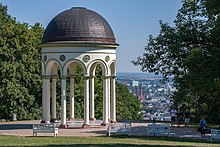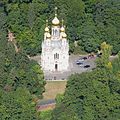Neroberg
| Neroberg | ||
|---|---|---|
|
Neroberg around 1900 |
||
| height | 245 m above sea level NN | |
| location | Wiesbaden , Hessen , Germany | |
| Mountains | Taunus | |
| Coordinates | 50 ° 5 '55 " N , 8 ° 13' 50" E | |
|
|
||
| particularities | Russian church, mountain railway, mountain park | |

The Neroberg ( 245 m above sea level ), formerly also called Ersberg , is the local mountain of the Hessian state capital Wiesbaden . It is a popular destination. The current name “Neroberg” was invented in the 19th century in reference to the city's Roman past.
Geographical location
The Neroberg is a southern branch of the Voraunus between the valleys of the Schwarzbach in the west and Dambach in the east, which ultimately drain into the Salzbach and then the Rhine via the Wiesbaden sewer system . Located on the northern outskirts of the inner city, it overlooks the Schlossplatz in the middle by 130 m. Both of its valley flanks and the greater part of the ridge are wooded, the summit and the upper southern slope are occupied by a park, underneath are vines on the steeper part of the southern slope. At the foot of the slope to the park-like, south-eastern hollow of the Schwarzbach, three rows of mostly upper-class houses stretch on both sides of the Weinbergstrasse and next to the lane on this side of the valley road called Nero Valley.
Russian Church
Visible from afar with its five gilded domes is the Russian Orthodox Church , which the Nassau Duke Adolph 1847-1855 as Sepulcher for his deceased wife in Russian-Byzantine style Elisabeth Mikhailovna was built, a niece of Tsar Alexander I and Nicholas I nearby is the Russian Orthodox cemetery from 1856, where numerous personalities are buried who settled in the city when it was still a world spa town . The most famous person buried here is the painter Alexej von Jawlensky (1865–1941).
Nerobergbahn
On the Neroberg from Nerotal leads since 1888 the Nerobergbahn up, one with water ballast powered funicular . Your two cars are connected by a steel cable that runs over a non-powered pulley in the mountain station . The tank of the above car is filled with up to 7,000 liters of water. On the following descent, the refueled car pulls the other up the mountain. The track consists of three rails , of which the middle one is shared by both vehicles . In the middle between the two rails of a track there is a rack . Both vehicles meet in the middle of the route at a passing point where the routes of the two vehicles share.
The aerial tramway travels at approx. 7.3 km / h and is regulated with a handbrake , which acts on the rack below via a gear . The filling quantity of the tank is measured according to the number of passengers to be transported . At the valley station the water tank is emptied and the water is pumped back up the mountain. This was originally done by a pump driven by a steam engine , now an electric motor . To save energy, the pump is only operated every three to four days.
On the ridge north of the mountain station you can see the route of an old water supply to the mountain station from the rear Neroberg by the stone covers of their access shafts in the forest.
Mountain park
On the top of the Neroberg, not far from the mountain station of the Nerobergbahn, Philipp Hoffmann created a small mountain park in 1851 .
Monopteros

The focal point is a monopteros designed by Philipp Hoffmann , from which one has a very good view of the city. Its pillars used to stand along Wilhelmstrasse and carried the oil lamps of the old street lighting. It was renovated from October 2010 to August 2013.
tower
The old Neroberghotel , which was also built nearby in the 19th century, fell victim to a fire in 1989. All that was left was the tower, which was renovated in 1993 and today houses a restaurant with a garden.
Lion terrace and memorial

A little below the park is a viewing terrace, which is flanked by two stone lions. These belong to a memorial erected in 1930 for those killed in the First World War of the Fusilier Regiment “von Gersdorff” (Kurhessisches) No. 80 and its war troop units, which was created by the architect Edmund Fabry and the sculptor Arnold Hensler . From the terrace you have a panoramic view of the vineyard, the villas of the Nero valley, the city of Wiesbaden and as far as Rheinhessen .
Recreational facilities
The Opel bath
- Next to the tower, an “adventure basin” was created, in which, among other things, the “Wiesbaden improv theater summer” with the improvisational theater ensemble “No liability for cloakroom” provides entertainment in summer .
- In the forest behind the adventure basin there has been the Neroberg climbing forest since June 2006 . The high ropes course with around 80 climbing elements was integrated into the tree population. The Neroberg climbing forest consists of several courses at different heights and with different degrees of difficulty.
- The so-called Opelbad between the Bergpark and the Russian Church, built in the clear lines of the New Building by the Austrian architect Franz Schuster , is one of the most beautiful outdoor pools in Germany, primarily because of its location. Wilhelm von Opel donated it in 1934.
Viticulture
The 4.1 hectare Wiesbadener Neroberg vineyard is located on the southern slope below the terrace and the Opel pool . Here , wine is grown exclusively from the Riesling grape variety on stony gneiss soil to which loamy loess is mixed . The wines are described as "fruity and spicy with a piquant acidity". The Neroberg vineyard , along with those of the Wiesbaden suburbs of Dotzheim , Frauenstein , Schierstein and Kostheim, is part of the Rheingau growing region .
When the site was cleared for viticulture, it was called “Ersberg” (“The rear mountain”), which became “Mersberg” or “Neresberg” in the 17th century . In 1900 the city acquired the vineyard from the state winery . Since October 1, 2005, the Hessian state wine estates have leased the location back. It is managed by the Rauenthal wine-growing domain.
Russian church on the Neroberghang with newly gilded domes
Aerial view of the Russian Orthodox Church of St. Elizabeth
A Nerobergbahn car in the mountain station
See also
literature
- G. Ulrich Großmann: Central and South Hesse , Dumont Verlag, Cologne 1995, ISBN 3-7701-2957-1 (pp. 122–123)
- Baedeker Wiesbaden Rheingau , Karl Baedeker GmbH, Ostfildern-Kemnat, 2001, ISBN 3879540764
Web links
Individual evidence
- ^ Neroberg . In: Heinrich August Pierer , Julius Löbe (Hrsg.): Universal Lexicon of the Present and the Past . 4th edition. tape 11 . Altenburg 1860, p. 791 ( zeno.org ).











